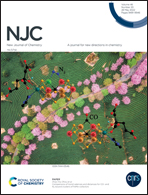Rational design of a 2D TiO2–MoO3 step-scheme heterostructure for boosted photocatalytic overall water splitting†
Abstract
The design of step-scheme (S-scheme) heterostructure photocatalysts is a promising strategy for the high utilization of photogenerated charge carriers. Herein, a novel S-scheme two-dimensional (2D) TiO2–MoO3 heterojunction photocatalyst is fabricated by a facile electrochemical method for high water splitting photocatalytic efficiency. According to X-ray photoelectron spectroscopy (XPS) assessment, electrons are transported from TiO2 to MoO3 upon close contact, creating an internal electric field (IEF) directed from TiO2 to MoO3. Hence, upon light irradiation, the photogenerated electrons in MoO3 move toward TiO2 under the IEF effect, as revealed by EPR analysis, implying that the S-scheme heterojunction was established in the TiO2–MoO3 heterostructure and significantly promoted the separation of electron–hole pairs to enhance efficient photocatalytic water splitting. Thanks to the 2D morphology of the TiO2–MoO3 heterojunction and the significantly improved redox capability of the charge carriers in the S-scheme system, the photocatalytic water splitting efficiency of the optimized TiO2–MoO3 is higher than those of both pure MoO3 and TiO2 and commercial TiO2–P25. This study, for the first time, presents the charge transfer pathways in the TiO2–MoO3 heterostructure photocatalyst via an S-scheme system. It will shed new light on the design and fabrication of novel step-scheme heterojunction photocatalysts for overall water splitting.



 Please wait while we load your content...
Please wait while we load your content...